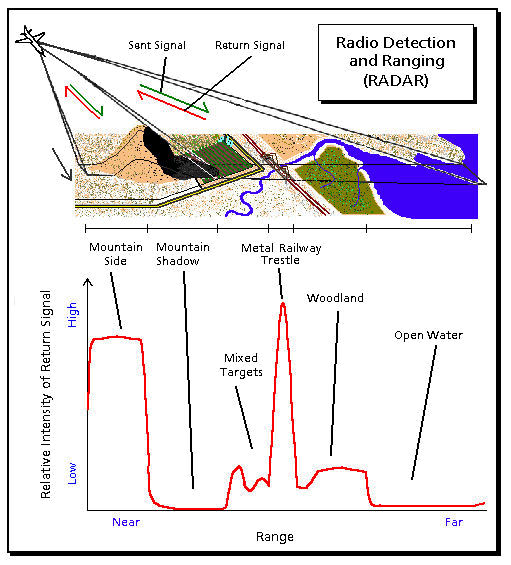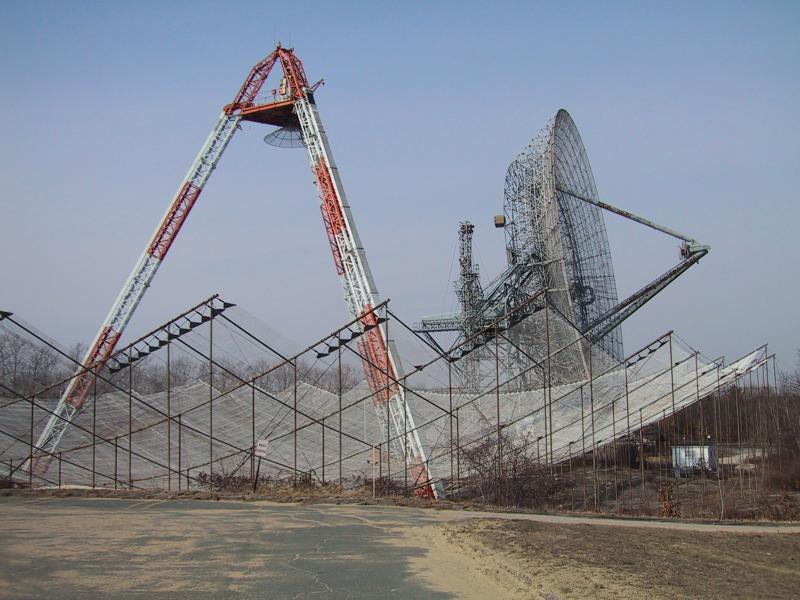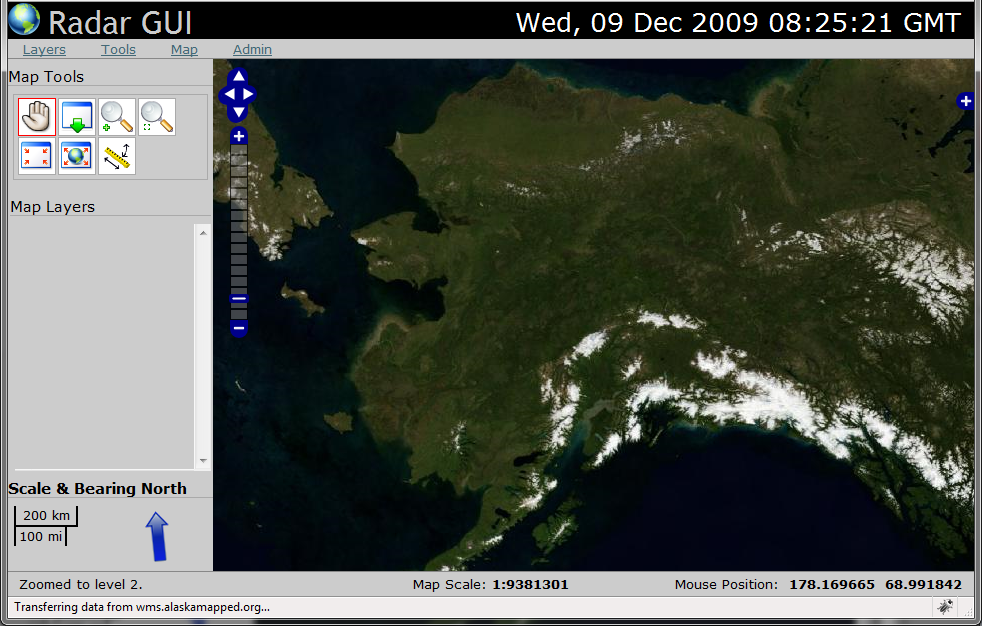What is a RADAR?
 A RADAR (hereafter: radar) is a device used in various applications to detect certain elements from physical
space. For example, a Doppler Radar is designed to detect the doppler shift of a metalically
reflective object. A Weather Radar will send microwaves into the atmosphere and get a return
signal off the precipitation. A Radar Gun (such as in your favorite police officer's radar
gun) sends out light waves at a specific frequency and can uses frequency modulation
to detect the velocity of the object.
A RADAR (hereafter: radar) is a device used in various applications to detect certain elements from physical
space. For example, a Doppler Radar is designed to detect the doppler shift of a metalically
reflective object. A Weather Radar will send microwaves into the atmosphere and get a return
signal off the precipitation. A Radar Gun (such as in your favorite police officer's radar
gun) sends out light waves at a specific frequency and can uses frequency modulation
to detect the velocity of the object.
Some radars use sonar and seismology. In fact, anything that sends or receives a signal (or both) can be classified as a radar.
What does RADAR stand for, anyway?
RADAR is a term coined in 1941 that stands for Radio Detection and Ranging. The key word in the term is radio which means it shoots out light waves. (Again, sonar radars exist so this argument is stifled.)
A bit of history
According to Wikipedia, "In August 1917 Nikola Tesla first established principles regarding frequency and power level for the first primitive radar units. He stated, '[...] by their [standing electromagnetic waves] use we may produce at will, from a sending station, an electrical effect in any particular region of the globe; [with which] we may determine the relative position or course of a moving object, such as a vessel at sea, the distance traversed by the same, or its speed.'" This is a resounding statement. In words, point some lightwaves at an object and hope it has a high reflectivity (metal works well for this) and you will get some return waves back to the receiving station.
Great Britain, the United States, France, and the Soviet Union in World War two gained on Tesla's principles and started patenting their radar technology. It was Great Britain during World War Two who first successfully utilized radar in their defense again the Axis powers. It was used in air defense.
Today radars are used in Air Traffic Control, Astrometry, highway speed control, and weather mapping, among other things.
The Physics
 Because a radar detects change in standing electromagnetic waves, and because objects,
especially conducting objects, give off radio waves as they move through an electromagnetic
system (usually, the earth in this case), radars detect change in electromagnetic flux. This
is directly related to the idea that a current in a wire can induce a magnetic field and
vice versa where a change in magnetic field can induce a current in a wire. Well, radars
are just detectors in changes in flux.
Because a radar detects change in standing electromagnetic waves, and because objects,
especially conducting objects, give off radio waves as they move through an electromagnetic
system (usually, the earth in this case), radars detect change in electromagnetic flux. This
is directly related to the idea that a current in a wire can induce a magnetic field and
vice versa where a change in magnetic field can induce a current in a wire. Well, radars
are just detectors in changes in flux.
Because we can measure where the "north" pole is in the earth's magnetic field, the same reasoning stands that we can find the "direction of change in magnetic flux" in a radar. Of course, these days with doppler radars, a radar will spin on an axis and radiate out in a given plane and based on where the rotating arm is for the radar that is where the angular position is relative to its "north" alignment. The principle is still the same.
Radiating Radars
In doppler radar, the unit will transmit radio waves in a cone, by some given offset from center. The center point of the radiation is its maximum power signal. When an object is detected, the object reflects back the same signal at a certain power level. The signal is coded by frequency. Here is a link to a table of common frequencies used in radar transmission. The return power level of the signal is given by
 (1)
(1)- Pt = transmitter power
- Gt = gain of the transmitting antenna
- Ar = effective aperture (area) of the receiving antenna
- s = radar cross section, or scattering coefficient, of the target
- F = pattern propagation factor
- Rt = distance from the transmitter to the target
- Rr = distance from the target to the receiver
- Source: http://en.wikipedia.org/wiki/Radar
In Equation 1, the transmitter and the receiver are not in the same location. In the event that they are, the figure above reduces to
 (2)
(2)Usefulness
 Recall Equation 2 in the previous page. The power of the received signal drops off at
a rate of R2. This shows that the return signal is very weak relative to the sent
signal. Also, by knowing the receiving power level, we can calculate the distance to the target.
Now we can combine the principles I've shown into what radars are most often used for: Range and
Bearing. Note, however, that with the correlation of another radar base station (we don't need
more than one signal) we can not know the altitude of the target in question. We have a good guess
due to the projected known angles and capabilities of the radar, but not accurate enough to use
in a safety situation.
Recall Equation 2 in the previous page. The power of the received signal drops off at
a rate of R2. This shows that the return signal is very weak relative to the sent
signal. Also, by knowing the receiving power level, we can calculate the distance to the target.
Now we can combine the principles I've shown into what radars are most often used for: Range and
Bearing. Note, however, that with the correlation of another radar base station (we don't need
more than one signal) we can not know the altitude of the target in question. We have a good guess
due to the projected known angles and capabilities of the radar, but not accurate enough to use
in a safety situation.
My Expertise
I'm no expert, nor is any knowlege of it "mine", but I do happen to be a programmer for the Geographic Information Network of Alaska. Right now, I am working with UAF's Poker Flat Research Range in developing a graphical user interface for a PSTAR (pdf file) radar system. I recently visted NASA Ames at Moffet Field in Mountain View, California (this is why I missed class for a week). We were safety certifying my application and my co-worker's Electronic Engineering hack for use at the rocket range during mission launches. NASA engineers from Wallops will be up here in January shortly after this class is over to re-certify any changes we've made to the system. Keep in mind that the RadarGUI application is UAF proprietary software and is still under development. Please don't expect a friendly user experience out of it. (Hint: If you don't see a map on start up, try clicking on the Map menu and clicking on Alaska.)
References
- http://www.wisegeek.com/how-does-radar-work.htm
- http://earth.rice.edu/mtpe/geo/geosphere/topics/remotesensing/25_radar.html
- http://www.naic.edu/~isradar/is/aboutis/radar.html
- http://physics.about.com/od/physicsintherealworld/f/dopplerradar.htm
- http://www.weatherquestions.com/How_does_weather_radar_work.htm
- http://www.radarguns.com/how-radar-guns-work.html
- http://acronyms.thefreedictionary.com/RADAR
- http://en.wikipedia.org/wiki/Radar

